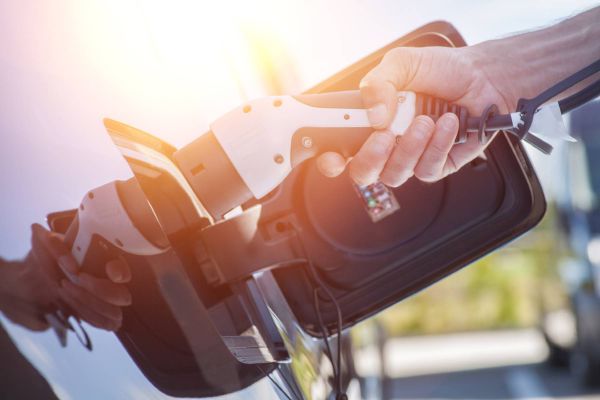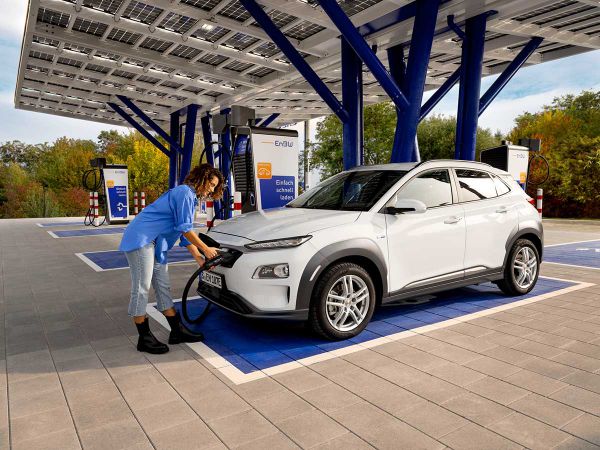Charging an electric car correctly: 9 tips for newcomers and professionals

As the heart of an electric car, you shouldpay particular attention to the battery. So far , lithium-ion batteries (LI-NMC) and lithium iron phosphate batteries (LFP) have been standard. As the storage capacity increases, the prices of the batteries increase significantly, but also increase comfort. When buying, you should pay attention to an appropriate capacity, as this decreases as the service life progresses. While they can't prevent the battery from aging, they can ensure that it remains powerful for a long time.
We have put together9 tips for you to help you charge your e-car optimally.
1. Choose the right charging cable and plug
Make sure that the charging station and plug are compatible with your vehicle. Also, be aware that there are different types of charging plugs, such as Type 2 or CCS in Europe. Which plug is the right one depends onwhich charging station you want to charge your e-car at.
2. Pay attention to the sequence of charging the e-car
In general, it is recommended to plug in the cable firstat the charging station and then at the car. After charging, you should first unplug the car and then unplug it from the station – if the cable is not firmly attached there. It can cause problems if the e-car is connected to the charging point in a different order.
3. Check the connection with the charger
The charging process does not start? Whether at a fast charging station (DC charging) or a normal charging station (AC charging, such as at the wallbox), check the connection to the charger. The plug should always be inserted correctly on both the car and the charging station and should not be tilted or "crooked". A fairly common cause at DC charging stations where the cable is attached to the station: Due to its weight, the charging cable pulls the plug down in such a way that it does not make sufficient contact with the electric car. This disrupts communication between the car and the charging station. Make sure that the plug is properly seated and that contact is made. If the plug looks too damaged, it is better to choose another charging station if in doubt.
Our3 tips for DC charging stations
Connect theelectric car to the charging station via the plug. The plug must be firmly plugged into the chargingsocket. Then start the charging process via app or charging card.
Pro tip 1: If you can't disconnect the plug from the vehicle after charging the electric car, try the following: Lock and unlock your electric car with the remote control (even with AC charging stations). As a rule, the vehicle automatically releases the plug after a few attempts. If your vehicle has an unlocking button, you can of course press it. Depending on the model, the position of the release button may vary. This is located either directly on the charging socket or in the interior, for example in the center console or on the vehicle key itself.
Pro tip 2: Lift the charging cable when unlocking and closing. Due to the weight of the cable, the unlocking mechanism may be blocked.
Pro tip 3: The plug is unlocked, but still stuck in the mechanics? Unplug the car with a little force. Of course, you should check in advance whether the charging process has already been completed. You can find this information either in the charging app (in the case of EnBW moblity+ in the "Charging Monitor") or at the charging station itself.

With small tricks, charging runs smoothly.
Immediate help in the EnBW mobility+ app in case of problems with the charging process
If there are any problems during the charging process at an EnBW charging station, the immediate help in the EnBW mobility+ app provides support. Users can use this fully automated self-service via smartphone . Thisr leads through a sequence of questions and instructions for action that lead to the solution of the problem. If the problem cannot be solved even by using the immediate help, it suggests the next available charging station with a suitable plug type so that the charging process can be started there.
4. Charging the e-car battery gently
To save the battery, you should not charge your electric car to 100 percent - unless you needthe maximum range. If you let the battery charge only to 80 – 90 percent as often as possible and avoid a complete discharge, you can help extend battery life. It is also best to leave the battery in a fully chargedstate for as short a time as possible. By the way, it is particularly time-efficient to start the charging process with the lowest possible battery charge level. The battery charges fastest when the charge level is lowand slows down as the charge level increases. This can be clearly observed in the charging curve that can be seen at E nBW fast-charging stations during the charging process.
5. Charging the e-car battery on holiday
If you don't need your electric car for several days or weeks – for example, because of holidays – you should pay attention to the battery level and conserve the battery. It is best to park the vehicle with a battery charge level (State of Charge = SoC) in the medium range between 30 and 70 percent. Please also note the note in the operating instructions if the service life is too long.
Even if the car is not used for a long time, you should not refrain from charging. According to experts, the battery is spared between 50 percent and 60 percent more with a continuous charge level than when it is not charged at all.
6. Pay attention to the correct charging rhythm: Don't charge every day
How often you have to charge your e-car depends on how you use it. Drive Everyday distances of less than 30 kilometers, it is not necessary to charge the car every day. However, if you are travelling longerdistances , for example on holiday or on weekend trips, you should of course charge your vehicle as needed.
7. Chargingan electric car with the right number of kilowatts
E-cars can be charged with different powers. Alternating current (AC charging via a wallbox) with a charging capacity of 3.7 to 22 kilowatts is most commonly used. DC charging stations offer direct current and thus a higher output of 50 to 400 kilowatts. Here you have the choice of using a normal or fast charging station. How many kilowatts you can charge your e-car with depends on various factors, especially the maximum possible charging power of the vehicle.
An example from the ADAC shows: While a Porsche Taycan or a Hyundai Ioniq 5 can be charged with well over 200 kilowatts of power, the limit of the Renault Zoe is reached at a maximum of 50 kilowatts.
If the plug is stuck, this is often due to the automatic unlocking.
8. Charging time for electric cars: fast charging only when needed
Depending on the charging station, e-cars need between 30 minutes and 14 hours to charge. In the technical documentation of the vehicle, you will find information about the charging time you can expect for the model until the battery is back at 100 percent. You can also estimate the time required yourself: charging time = battery capacity in kilowatt hour / charging power in kilowatts. Depending on the model, electric cars can be charged with 50 kilowatts or up to 270 kilowatts, which has a significant impact on the charging time. However, it should be noted that there is a charging curve and the vehicle charges faster at the beginning than in the later course. It is best to pay attention to the time indicated on the display of your charging station.
For daily charging, it is practical to use the options at home, for example at the wallbox. Some manufacturers recommend using direct current (DC) charging stations only when needed. E-cars should therefore ideally be charged slowly.
9. Charging an e-car in rain, thunderstorms and cold: yes safe
In rain and thunderstorms, charging the electric car isbasically safe. The insulation of charging plugs providesthe best possible protection and prevents moisture from entering. This prevents damage caused by short circuits. In the cold, however, many cars charge more slowly. Charging times can then be significantly longer. At low temperatures, it therefore makes sense to pre-temperature the battery.